YMO 101: The Pre-Cursors and Side Projects

This is part five of my guide to Yellow Magic Orchestra.
Part 1: The Studio Albums
Part 2: The Live Albums
Part 3: The Compilations and Remix Records
Part 4: The Solo Records
Part 6: The Protégés, Associates and Etc.
If you get big enough into any band that had any kind of success, you’ll start to look out for side-projects, pre-cursors and follow-ups. Sometimes this can lead you down a great road of musical discoveries. I’m sure many a young Zeppelin fan didn’t get into The Yardbirds until they found out Jimmy Page was in the group. And Pearl Jam fanatics of the 90s got to discover the entire foundation of the grunge genre with Green River and Mudhoney. But charting a band’s musical tree doesn’t always work out so well. I pity the Slipknot fan who bought anything by Stone Sour expecting anything resembling actual music. And while they’ll always have “Genius Of Love,” anyone who thinks that Tom Tom Club are a worthy companion to Talking Heads are just fooling themselves.
Luckily, the YMO fan looking to explore the various bands that Yukihiro Takahashi, Haruomi Hosono and Ryuichi Sakamoto have called themselves members of is in luck; those groups include some of the most influential and important bands in Japanese rock history, fun upbeat pop music, easy-listening jazz, and some interesting experimental electronic offshoots.
Only one of them is godawful horrible.
Apyrl Fool
This is Hosono’s very first group, 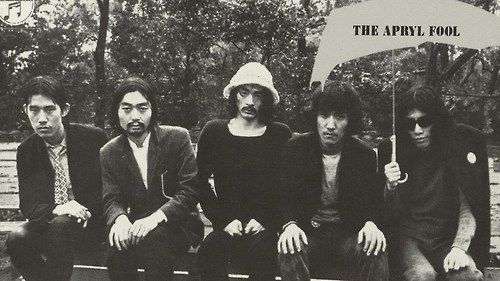 they just released one record, a self-titled album that came out in 1969. It is a psychedelic blues-rock album, very similar to pre-Dark Side Pink Floyd in a lot of ways. I haven’t really absorbed it yet. But it’s definitely a quality record made by a group of incredibly talented musicians, even if the music isn’t my thing.
they just released one record, a self-titled album that came out in 1969. It is a psychedelic blues-rock album, very similar to pre-Dark Side Pink Floyd in a lot of ways. I haven’t really absorbed it yet. But it’s definitely a quality record made by a group of incredibly talented musicians, even if the music isn’t my thing.
A lot of people really dig this album. I routinely see early pressings of it go for astronomical amounts at the record stores here in Japan. So it definitely has a following that swear by it. Check it out on YouTube. If you enjoy it, you can probably find an affordable copy on CD. It’s also available on Amazon’s US MP3 store.
Happy End
Hosono followed up Apyrl Fool with Happy End,  which also featured influential singer/songwriter Eiichi Ohtaki and occasional Akiko Yano collaborator Shigeru Suzuki.
which also featured influential singer/songwriter Eiichi Ohtaki and occasional Akiko Yano collaborator Shigeru Suzuki.
It’s really hard to understate the importance of Happy End in Japanese rock music. They were one of the first Japanese rock acts to sing in Japanese, which was a big deal at the time. And a lot of what I read cite the group as the single most influential, and best, Japanese rock act of the 70s.
I don’t really like them.
I know they’re great, I get why they’re great, and I won’t besmirch anyone who disagrees with me. But most of their stuff is soft rock, and that’s probably my least favorite genre of all-time. I just can’t get into this stuff in my own language, let alone Japanese. I’m sorry. Maybe I’ll try again sometime.
But hey, if that’s your thing then you’re in luck, every Happy End album is incredibly easy to find at affordable prices. Go nuts.
The Sadistic Mika Band/The Sadistics
The Sadistic Mika Band is to Yukihiro Takahashi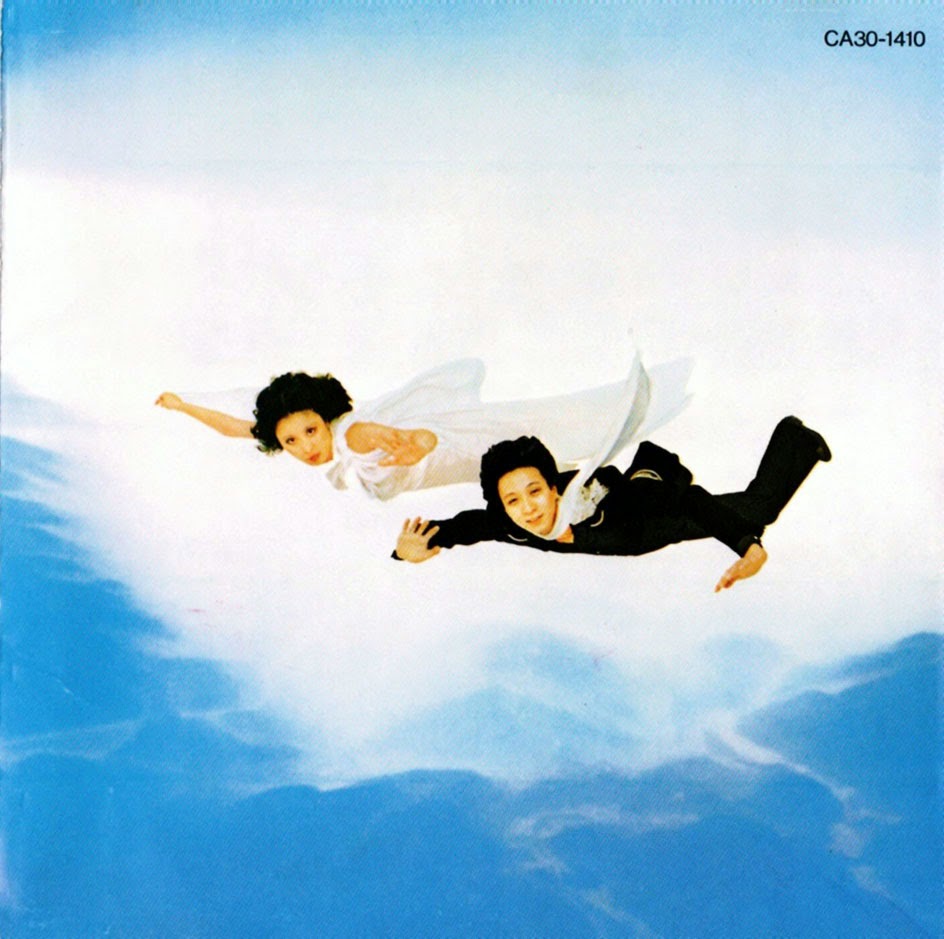 as Happy End is to Hosono; a hugely influential and important 70s Japanese rock band with fans to this day. In addition to Takahashi, the group also featured Kazuhiko Katoh on guitars and occasional vocals, who
as Happy End is to Hosono; a hugely influential and important 70s Japanese rock band with fans to this day. In addition to Takahashi, the group also featured Kazuhiko Katoh on guitars and occasional vocals, who
happens to be one of my favorite Japanese musicians outside of YMO.
They’re an undeniably great band, albeit far removed from anything resembling the music that Takahashi would be known for from the 80s onward. The majority of their output straddles a line between surf rock, progressive and psychedelia. If any of that sounds like something you might be into, then I suggest going after any of their records. You’ll probably be happy with any of the original band’s first few albums and possibly some of stuff they put out as The Sadistics, which was the name they took after lead singer Mika quit.
Tin Pan Alley
A kinda funky/mellow jazz/pop ensemble that Hosono was in for a brief stint in the 1970s. These guys were also very influential in some circles and I continue to see their albums re-released or showcased at record shows from time to time. In fact, I saw them live without even knowing it when I bought tickets to see Akiko Yano and it turned out that Tin Pan (complete with Hosono) were serving as her back-up band.
These guys are musical maniacs. If you’ve ever wanted proof that Hosono is a bass virtuoso, just listen to a bit of their first album. “Chopper’s Paradise” is pretty incredible.
As was the case with the bands prior though, I feel that I have to issue the “this sounds absolutely nothing like YMO” disclaimer. These guys are pretty mellow, with light rock and jazz being their forte. I bet they really like Steely Dan.
Friends Of Earth (FOE)
This was Hosono’s side-project that he launched immediately after YMO disbanded in the mid-80s. In fact, his first solo album after the break-up, the excellent S-F-X, is actually credited to Hosono and FOE together, but I decided to put that in his solo discography because that’s what most people here in Japan seem to do.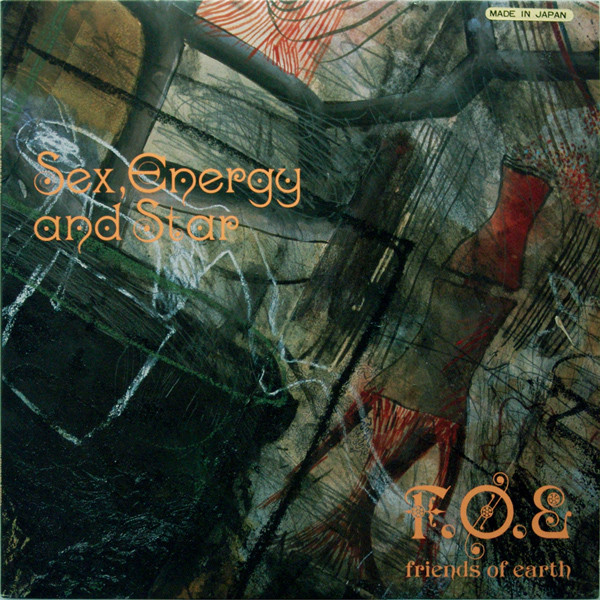
FOE’s only full-length album that features Hosono as part of the group proper is Sex Energy and Star, which came out in 1986. It opens with a revision of James Brown’s “Sex Machine,” complete with newly recorded lyrics by James Brown that he laid down especially for this album. So yeah, that’s weird. Equally weird is the group’s take on “Right Place, Wrong Time,” which re-imagines the Dr. John classic as a jazzy synth/funk jam piece.
But both the tracks are actually pretty good. In fact, the entire album is good. Although it’s electronic pop, it’s not much like YMO. It has a heavy preference for digital samples over more organic synthesizers, but it’s done creatively and at times even subtly. “Total Eclipse,” featuring vocals by Miharu Koshi, is one of the most beautiful things that Hosono has ever recorded, while “In My Jungle” does a good job of combining Hosono’s interest in “tropical” music with his synth-pop sound. Good stuff. Always love me some synthesized steel drums.
FOE also released a few random EPs and singles, and those were all collected on a compilation called The World Of FOE. This record is a little more uneven than their album proper, but considering its a hodgepodge of tunes thrown together into a proper album, I suppose that makes sense. It does include its fair share of stand-out tunes though, including a different mix of the excellent “Body Snatchers,” which first showed up on the S-F-X album. Also of note are the beautiful “Decline Of The City” and the groovy electro jam “Agricult.”
However, and this is a big however, this album also includes Hosono’s very ill-advised forays into hip-hop and rap. These tracks are not good. “OTT Manifesto (OTT Mix)” sounds like a bunch of middle-aged Japanese men trying to rip-off the Krush Groove soundtrack, probably because that’s what it actually is. Not recommended. And “Dance Hall” is just unlistenable and atrocious.
Still, “Body Snatchers” is a great song, and the other stuff on here is actually worth a listen too, just be ready to skip the dark patches.
Love, Peace & Trance
A one-off side-project by Hosono featuring three Japanese female singers and some lesser-known electronic musicians. They released one self-titled album in 1995.
Most important thing to get out of the way, this is not a trance act. This is not a trance album. Nothing here has anything to do with trance whatsoever. I don’t know why the project has “trance” in its name. Was Hosono mistaken as to what trance actually is? Does “trance” mean something else in Japan? I have no idea. Regardless, this is not a trance album.
What it is, in fact, is a pretty decent ambient record. Some of the parts with vocals are vaguely mid-90s “world music” ala Deep Forest, but most of it is just chill vibes all the way. Hosono was good at this, too bad he only kept it up for this one album.
HAT
 Wait, I guess he didn’t. HAT picks up where Love Peace & Trance left off, although with a much heavier slide into the then-burgeoning glitch/IDM sound of the late-90s. Hosono ditched the vocalists for this one, and instead worked alongside two other electronic musicians; Uwe Schmidt and Tetsu Inoue (both of whom have released countless records other various names an in other assorted projects).
Wait, I guess he didn’t. HAT picks up where Love Peace & Trance left off, although with a much heavier slide into the then-burgeoning glitch/IDM sound of the late-90s. Hosono ditched the vocalists for this one, and instead worked alongside two other electronic musicians; Uwe Schmidt and Tetsu Inoue (both of whom have released countless records other various names an in other assorted projects).
They have two albums, Tokyo – Frankfurt – New York (1996) and DSP-Holiday (1998). I’m shocked that Warp Records wasn’t involved in either, they both sound like something that label would’ve eaten up at the time. Definitely for fans of Autechure, Speedy J, or anything else you might’ve found on an Artificial Intelligence compilation.
Geisha Girls
Here’s the bad one.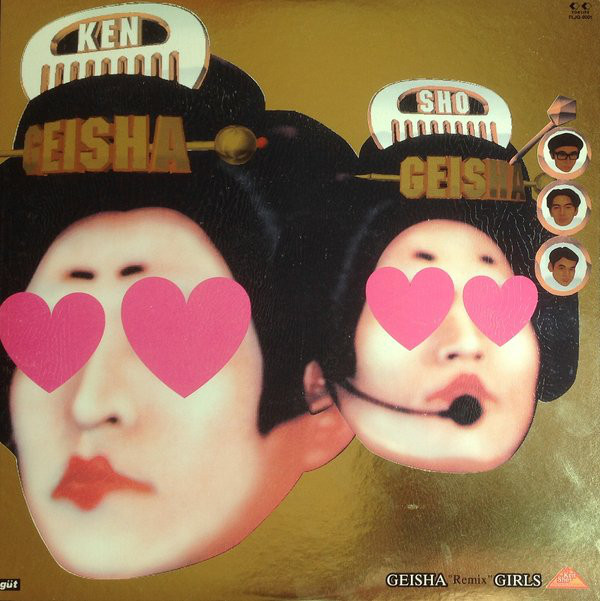
Geisha Girls was a collaboration between Ryuichi Sakamoto, Satoshi Tomiie and Towa Tei. Three legends of Japanese electronic music. It must be amazing, right?
Oh wait, it’s primarily a comedy record with the occasional diversion into Japanese hip-hop. Nevermind.
That may sound dismissive, but unless you’re a fan of Japanese comedy (and speak fluent Japanese) then there is zero reason to buy this record. It’s mostly comedy bits with little musical accompaniment, or they’re comedic songs that will be entirely lost on anyone who doesn’t speak Japanese. Is it funny? I don’t know. But considering the quality of most Japanese comedy I’ve encountered, I doubt it.
(Look, I’m sure there’s plenty of great Japanese comedy out there, but most of the mainstream Japanese comedy I’ve heard or seen relies heavily on stereotypes or is so broad and generic that it’s impossible to find much humor in it. I’m sure there’s plenty of good Japanese comedy that I just haven’t come across. Don’t send me hate mail about it.)
There is literally one good song on this album, “Agatte,” which I’ll share over at Lost Turntable at some point, so look for it there and just avoid this album entirely.
Sketch Show
This is a hard one to write about,  because at times, Sketch Show was literally YMO.
because at times, Sketch Show was literally YMO.
Let me explain.
Sketch Show was officially Haruomi Hosono and Yukihiro Takahashi. Their debut album, Audio Sponge, was released in 2002. On that album, Ryuichi Sakamoto joined them for a couple of tracks, making it a full-fledged YMO reunion in a way. Sakamoto even came along for a few shows on tour. In 2003 the group would release Loophole, which also featured some collaborations with Sakamoto. A year later, the trio went on tour under the name Human Audio Sponge, or HAS. Later on, they toured as HAS/YMO, performing a combination of Sketech Show and YMO tracks. More recently, they dropped the HAS front entirely, and are now just YMO again (although the last time they played a live show was in 2012).
So if you like YMO, you should like Sketch Show, right?
Absolutely not.
I think their music is fascinating, but even I get annoyed by it at times. Definitely not for everyone, but everyone should at least give it a chance via YouTube or something to see if it is for them.
Takahashi/Jansen (aka Pulse)
The Jansen of Takahashi/Jansen 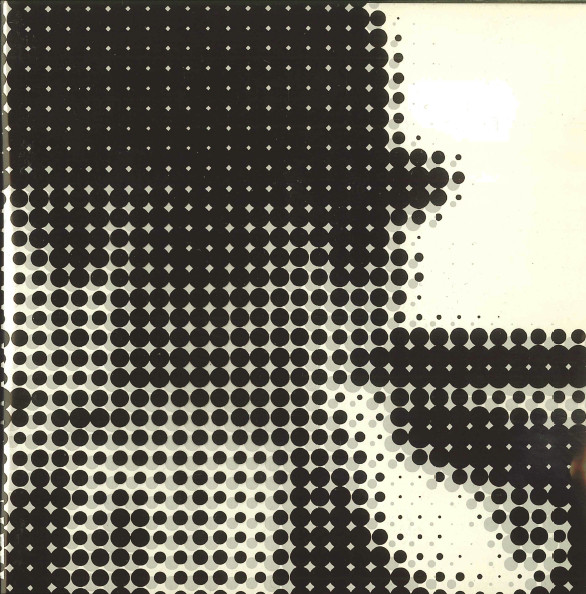 is Steve Jansen, the drummer for the English art-rock group Japan. They first teamed up in 1986 for Stay Close, a quick three-track single. It’s okay, kind of forgettable.
is Steve Jansen, the drummer for the English art-rock group Japan. They first teamed up in 1986 for Stay Close, a quick three-track single. It’s okay, kind of forgettable.
The Beatniks
Another Takahashi offshoot, 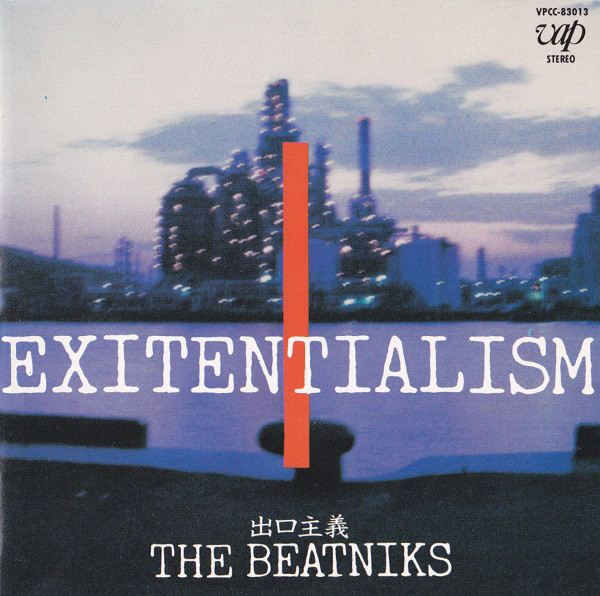 this one a duo featuring him alongside Keiichi Suzuki. Suzuki is an incredibly well-known musician in Japan, most famous for his work with the popular rock group The Moonriders. However, if you’re not Japanese and you recognize his name, it’s probably because he served as the composer to the classic game Mother 2 (aka Earthbound).
this one a duo featuring him alongside Keiichi Suzuki. Suzuki is an incredibly well-known musician in Japan, most famous for his work with the popular rock group The Moonriders. However, if you’re not Japanese and you recognize his name, it’s probably because he served as the composer to the classic game Mother 2 (aka Earthbound).
The Beatniks have released a few albums. Their first, 1981’s Existentialism, is a must-buy. It’s very similar to Takahashi’s solo output of the early-80s, but a bit more varied. It has the poppy melodic numbers you can expect from Takahashi of the era, like “River In The Ocean” and “Mirrors,” but as a whole it’s far more experimental than his typical solo fare. “Loopy” and other tracks are more soundscapes than proper tunes. Additionally, it’s far darker and bleak than most of his solo work. “Now And Then” and “Now Way Out” are just heartbreaking tunes that will kick your ass if you let them.
They’ve released three other records since then, and sadly none of them hold a candle to their debut and I just can’t recommend them. They’re far too similar to Takahashi’s late-80s and early-90s output of downtempo pop drivel to even warrant a courtesy listen.
Their remix album, Another High Exit, isn’t bad though.
Metafive
The latest YMO-side project of note, and probably one of the very best as well. This is a technopop supergroup of sorts. Not only is it fronted by Yukihiro Takahashi, but the group also features Japanese electronic superstars Towa Tei (of Deee-Lite fame), Cornelius, and Yoshinori Sunahara (formerly of Denki Groove). Rounding out the group is Takahashi collaborator Tomohiko Kondo, and vocalist Leo Imai.
Yes, I know that’s six members, the full name of the group was originally “Yukihiro Takahashi and the Metafive.”
Numeric semantics aside, the group is fantastic, and is the ideal group for 2017’s YMO fan; modern yet retro, old-school with some new ideas thrown in. They have none of the glitch elements found in most of Takahashi’s 21st century work, and instead are focused purely on fun electronic pop music. They’re absolutely fantastic, and I cannot recommend them enough. Their 2016 self-titled studio album as a good starting point, followed by the Metahalf EP that they put out that year as well. Both of these are on the US iTunes and Amazon MP3 stores.
They also have two live albums, Metalive (which also came out in 2016), and Techno Recital, which was the band’s first release back in 2014. As that album was recorded before they actually went in the studio, it’s entirely cover tunes, focusing mostly on Takahashi’s solo work with a few YMO tracks (and a Towa Tei tune) thrown in. It’s a good record, but I would go for Metalive more. The Metafive tunes are much more upbeat than Takahashi’s solo stuff, so they work better in a live setting.
Metalive also includes a performance of “Radio Junk” aka the best YMO song, so there’s that too.
As always, if you have any other recommendations for YMO-associated acts, leave them in the comments. Up next, I’ll take a look at the various acts that YMO members produced records for and/or performed with. That one is going to be a doozy.
Leave a Reply